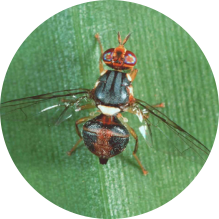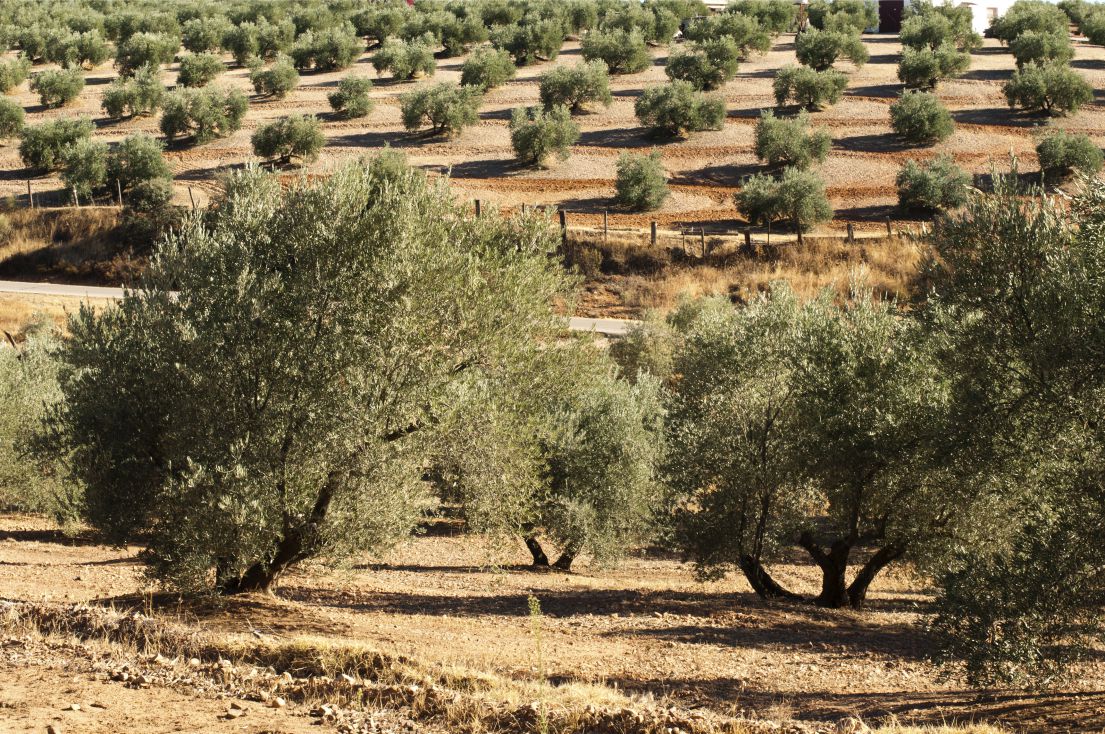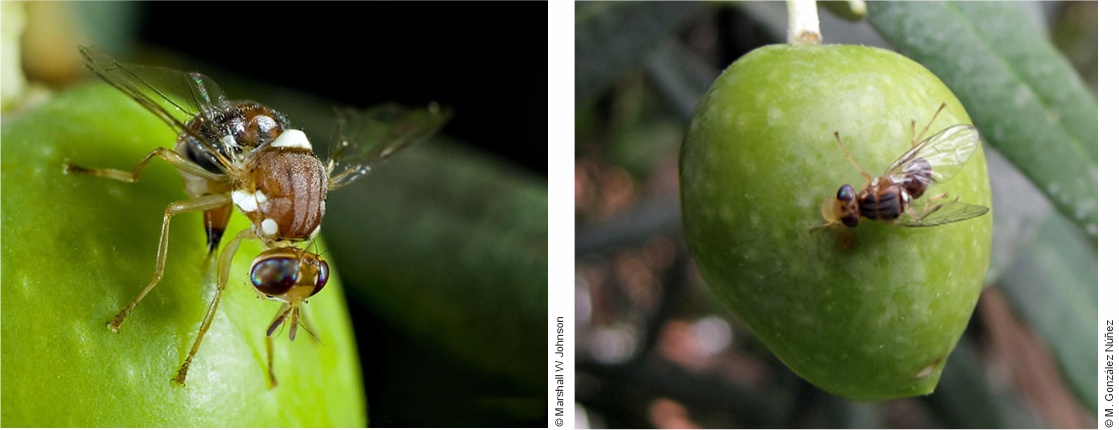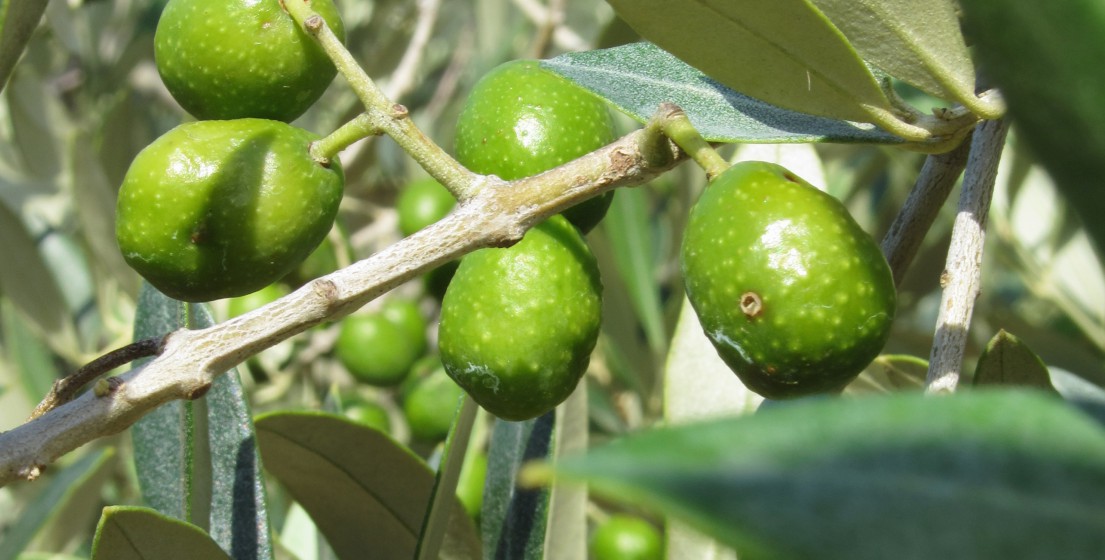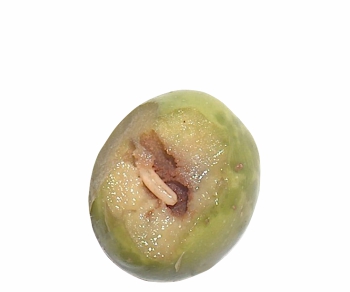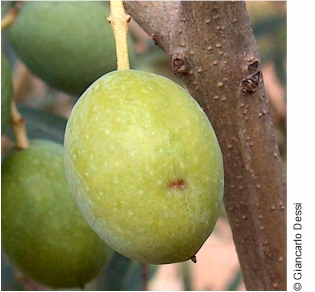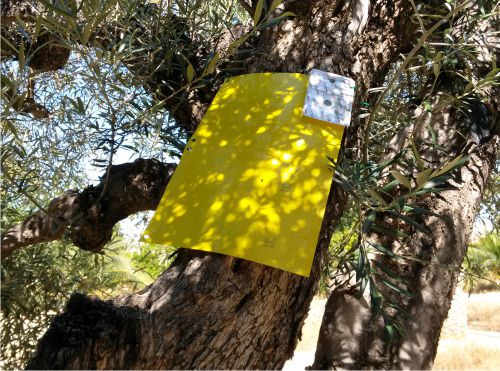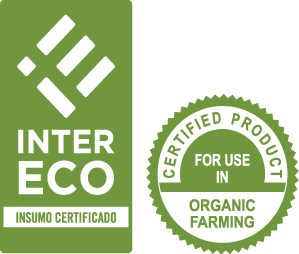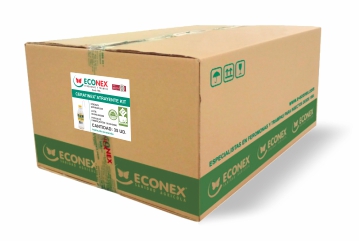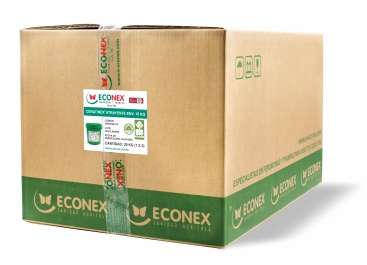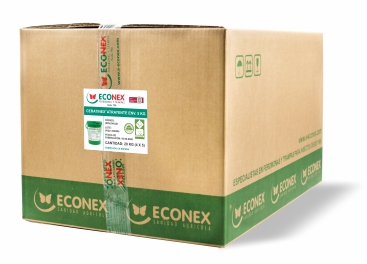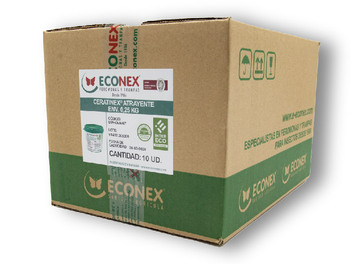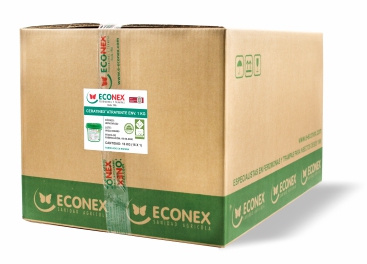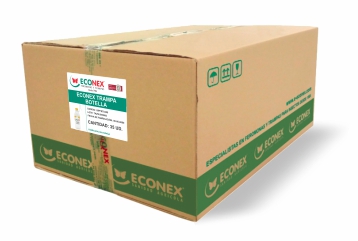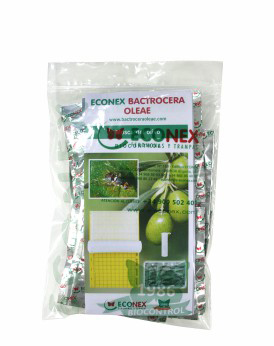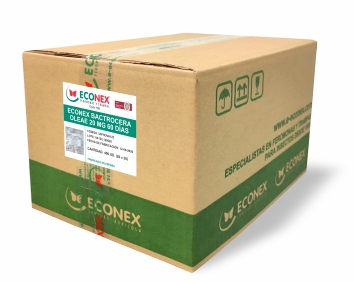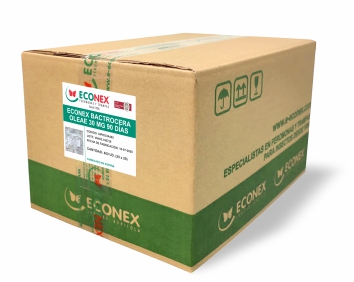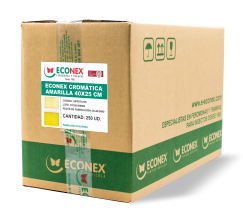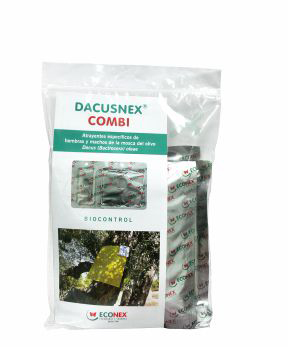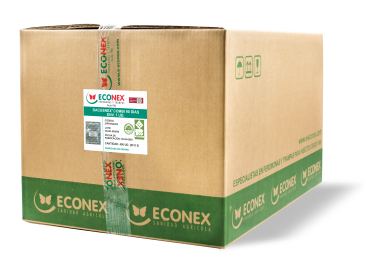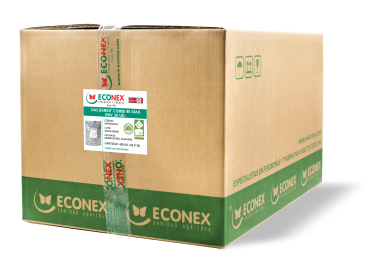CERATINEX® ATTRACTANT
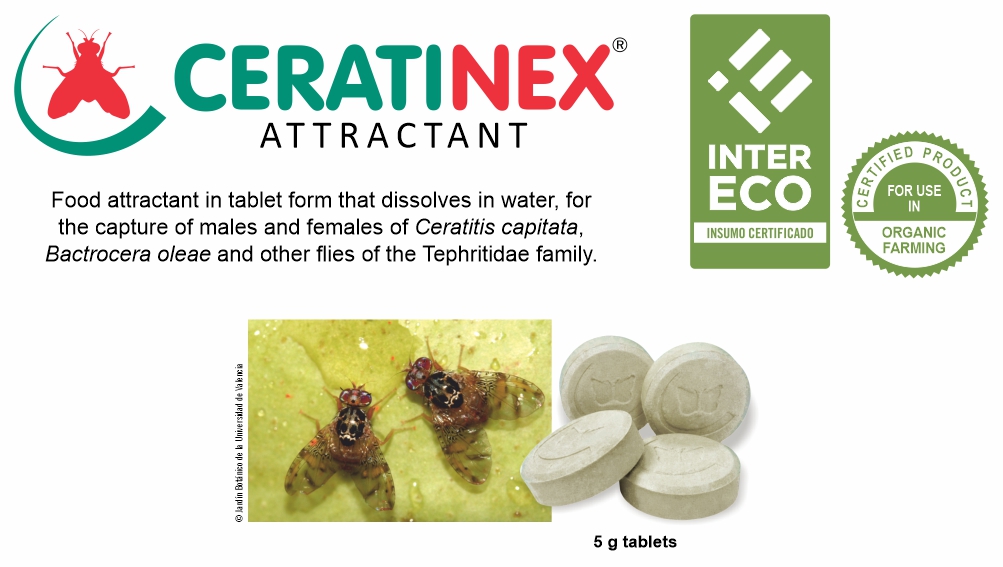
CERATINEX® ATTRACTANT KIT
Bottle-shaped disposable trap in the form of a closed bottle. It has 4 diagonal holes with yellow polypropylene inserts that have a truncated cone shape. These inserts make it easier for the target insects to enter the
trap, both by chromotropic attraction as well as its funnel shape, also preventing their exit. The trap contains four tablets (20 g) of food attractant to dissolve in 500 ml of water. The trap includes a wire hanger
to hang from a branch.
It lasts approximately 100 days in normal field conditions, provided that the level of water remains stable. This will depend on temperature, relative humidity, wind and sun exposure.
INSTRUCTIONS: Take the bottle cap off, add 500 ml of water (up to the indicated level on the inside sticker), close the bottle cap again, remove the upper label to open the holes and hang the bottle from a branch on the
sunny side of the tree. Refill the bottle if more than 1/3 of water evaporates.
PRODUCT STORAGE: The product must be stored away from food and beverages in its original packaging, in a cool, dry place, in which case it will remain valid for 3 years from the date of manufacture.
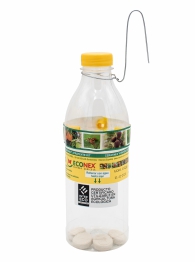
CERATINEX® ATTRACTANT KIT
Kit composed of a disposable trap with four tablets of food attractant to dilute in water + 1 hanger
Code: UIPHOVA345
OMDF register number (Ministry of Agriculture of Spain): 120/2015

CERATINEX® ATTRACTANT + ECONEX BOTTLE TRAP
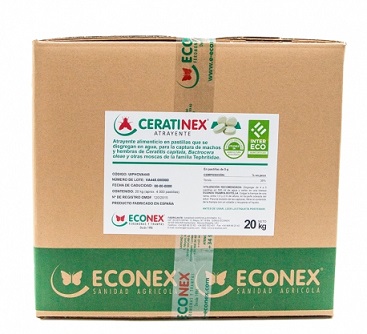
CERATINEX® ATTRACTANT 20 KG
Container with 20 kg of product.
(4000 tablets)
Code: UIPHOVA448
OMDF register number (Ministry of Agriculture of Spain): 120/2015

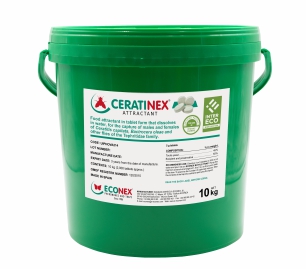
CERATINEX® ATTRACTANT 10 KG
Container with 10 kg of product.
(2000 tablets)
Code: UIPHOVA214
OMDF register number (Ministry of Agriculture of Spain): 120/2015

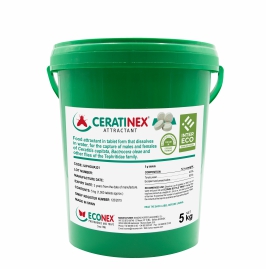
CERATINEX® ATTRACTANT 5 KG
Container with 5 kg of product.
(1000 tablets)
Code: UIPHOVA321
OMDF register number (Ministry of Agriculture of Spain): 120/2015

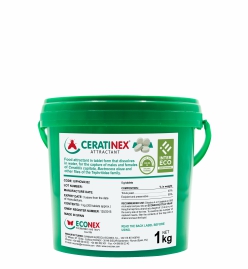
CERATINEX® ATTRACTANT 1 KG
Container with 1 kg of product.
(200 tablets)
Code: UIPHOVA322
OMDF register number (Ministry of Agriculture of Spain): 120/2015

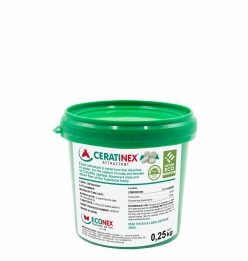
CERATINEX® ATTRACTANT 0,25 KG
Container with 0,25 kg of product.
(50 tablets)
Code: UIPHOVA333
OMDF register number (Ministry of Agriculture of Spain): 120/2015

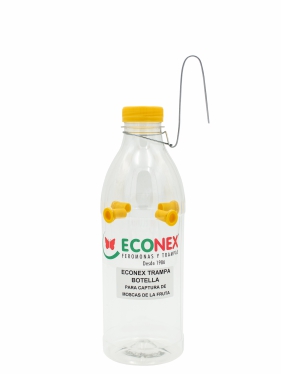
ECONEX BOTTLE TRAP
Code: UIPFETA250
OMDF register number (Ministry of Agriculture of Spain): 009/2025

Recommended use
Dissolve 4 or 5 tablets in 500 ml of water and pour into an ECONEX BOTTLE TRAP.
Hang the trap from a branch at a height of 1.5 to 2 m, on the sunny side of the tree.
To examine the captures, you have to filter the contents of the trap into a strainer and keep the liquid.
It lasts approximately 100 days in normal field conditions, depending on temperature, relative humidity, degree of sun exposure and type of trap used.
Activation
Activate the trap by dissolving 4 or 5 tablets in 500 ml of water.
Detection and monitoring
Place 1 or 2 traps per hectare. The traps must be activated at least 2 weeks before the start of the target insect’s flight period.
Mass trapping
Increase the number of traps per hectare. It could be necessary from 70 to 120 traps/ha.
Storing the diffusers
The product must be stored away from food and beverages in its original packaging, in a cool, dry place. In these conditions, it will last for 3 years from the production date.
ECONEX BACTROCERA OLEAE 20 MG 60 DAYS
ECONEX BACTROCERA OLEAE 30 MG 90 DAYS
Pheromone diffuser to attract males of the Olive fruit fly
Bactrocera oleae + 1 hanger in the form of a clip. It lasts for 60 and 90 days respectively.
The diffuser is a polyethylene tube that is individually packaged in an aluminium sachet with labelled specifications.
Once removed from its packaging, the diffuser needs no activation or opening, just placed correctly in the trap.
Necessary material
In general, the diffuser is used together with an ECONEX YELLOW CHROMATIC 40 X 25 CM so that the flies attracted by the diffuser are caught on the adhesive of the trap. Once the trap has been placed on the olive tree, attach the
ECONEX BACTROCERA OLEAE 20 MG 60 DAYS diffuser, or the ECONEX BACTROCERA OLEAE 30 MG 90 DAYS diffuser to one of the holes of the trap. Use the paperclip hanger provided with the product.
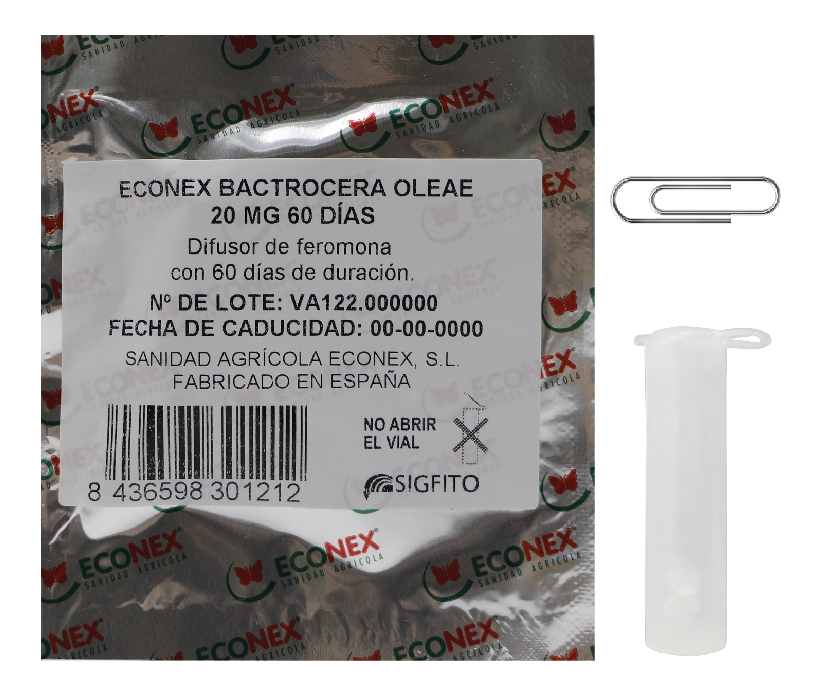
ECONEX BACTROCERA OLEAE 20 MG 60 DAYS
Packaging, attractant+pheromone of Bactrocera oleae.
Code: UIPHOVA122
OMDF register number (Ministry of Agriculture of Spain): 074/2013

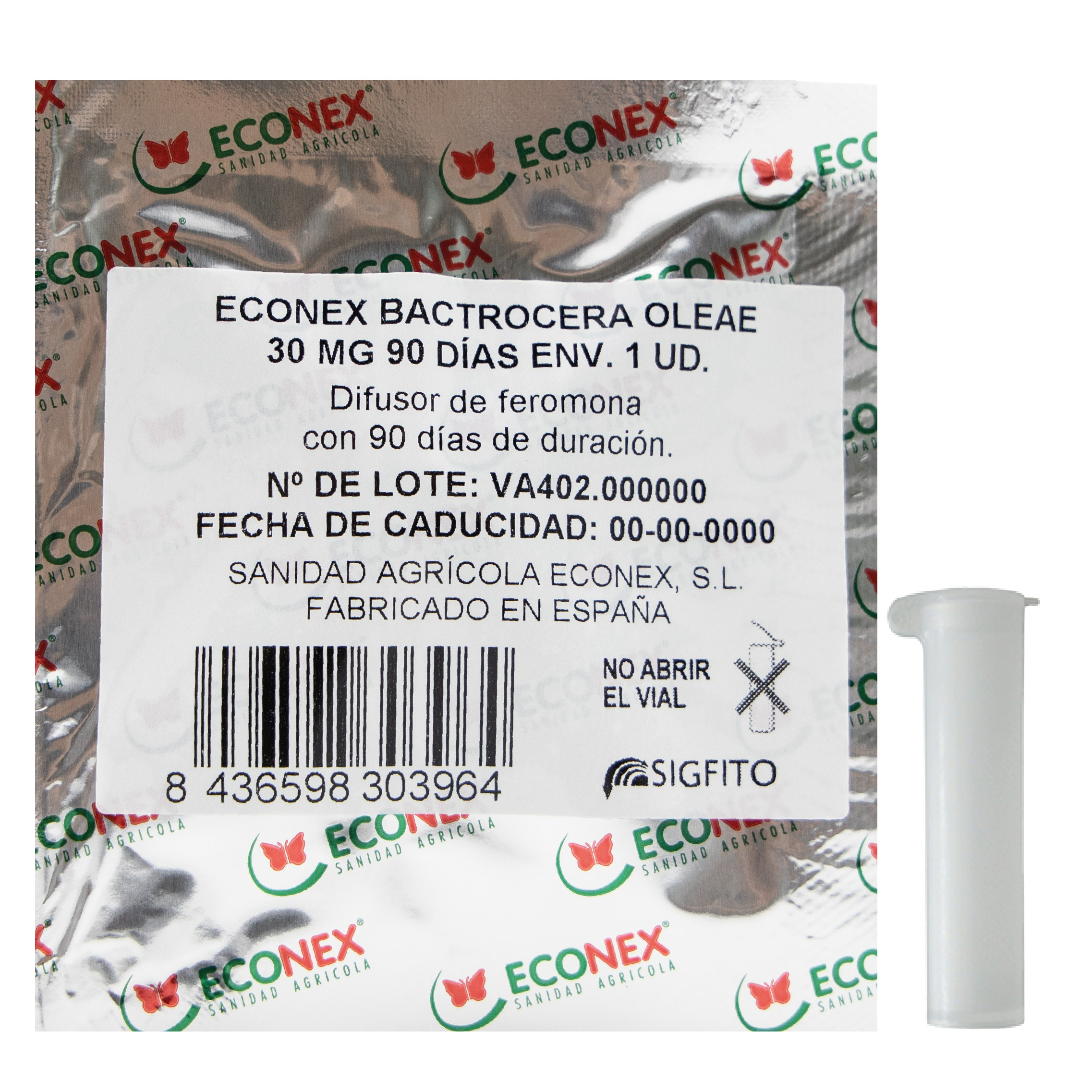
ECONEX BACTROCERA OLEAE 30 MG 90 DAYS
Packaging, attractant+pheromone of Bactrocera oleae.
Code: UIPHOVA402


ECONEX YELLOW CHROMATIC 40 X 25 CM
Adhesive chromatic trap consisting of a light-resistant polyethylene yellow sheet of 1,000 cm2 (40 x 25 cm), with a 2x2 cm grid printed in black, on both sides.
Code: UIPFETA125
OMDF register number (Ministry of Agriculture of Spain): 029/2023

DACUSNEX® COMBI
DACUSNEX® COMBI is a product authorised for use in organic farming. It is a combination of 2 attractants: a food attractant and the female pheromone attractant of Dacus (Bactrocera) oleae to attract female and male Olive fruit flies.
The diffuser is a blister pack which is individually packaged in an aluminium sachet with labelled specifications. It lasts for 90 days under normal field conditions.
Once removed from its packaging, the diffuser does not need activating or opening, just placed correctly in the trap.
Necessary material
In general DACUSNEX® COMBI is used together with an ECONEX YELLOW CHROMATIC 40 X 25 CM so that the flies attracted by the diffuser are caught on the adhesive of the trap.
Once the trap has been placed on the olive tree, attach the DACUSNEX® COMBI 90 DAYS diffuser to one of the holes of the trap. Use the paperclip hanger provided with the product. Do not place the metallic part in contact with the adhesive.
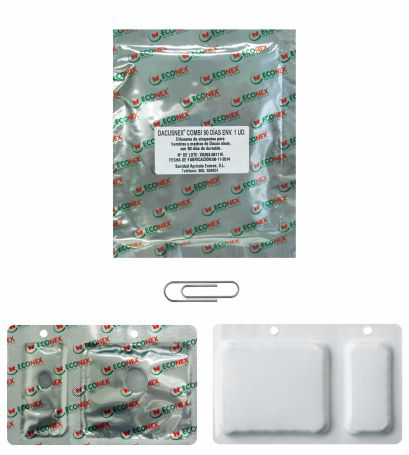
DACUSNEX® COMBI 90 DAYS 1 UNIT
Packaging, hanger and attractants diffuser.(front and back view)
Code: UIPHOVA253
OMDF register number (Ministry of Agriculture of Spain): 087/2015

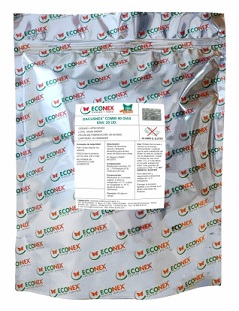
DACUSNEX® COMBI 90 DAYS
20 UNITS
DACUSNEX® COMBI is a combination of 2 attractants. The first is a food attractant and the second is the female pheromone of Dacus (Bactrocera) oleae, to attract the female and male species of the Olive fruit fly.
Code: UIPHOVA334
OMDF register number (Ministry of Agriculture of Spain): 087/2015


ECONEX YELLOW CHROMATIC 40 X 25 CM
Adhesive chromatic trap consisting of a light-resistant polyethylene yellow sheet of 1,000 cm2 (40 x 25 cm), with a 2x2 cm grid printed in black, on both sides.
Code: UIPFETA125
OMDF register number (Ministry of Agriculture of Spain): 087/2015

Storing the diffusers
The diffusers must be stored in their original packaging in a cool and dry place and separated from food and drinks.
To preserve the diffusers for long periods of time, it is recommended to keep them in the refrigerator at 4 o C in which case they will last for 2 years. Or they can be kept in the freezer at -20 o C for 4 years.
Recommended information:
CERATINEX® ATTRACTANT LEAFLET
Leaflet in PDF format that can be downloaded by clicking on the image.

ECONEX BACTROCERA OLEAE LEAFLET
Leaflet in PDF format that can be downloaded by clicking on the image.

ECONEX DACUSNEX© COMBI LEAFLET
Leaflet in PDF format that can be downloaded by clicking on the image.

ECONEX LEARNING CENTER
ECONEX puts at your disposal the first open knowledge center that brings together everything necessary to implement pest biocontrol in your crops. We have developed different types of resources to share with you the knowledge we have acquired during our more than 38 years of experience. Each of them is designed to respond, in the best possible way, to different questions related to pheromones, attractants, repellents and insect traps.
To access ECONEX LEARNING CENTER click on the image.

